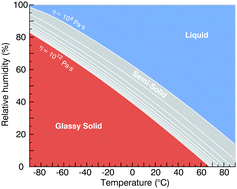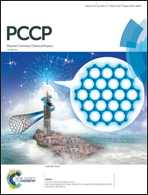Characterization of the temperature and humidity-dependent phase diagram of amorphous nanoscale organic aerosols†
Abstract
Atmospheric aerosols can exist in amorphous semi-solid or glassy phase states. These states are determined by the temperature (T) and relative humidity (RH). New measurements of viscosity for amorphous semi-solid nanometer size sucrose particles as a function of T and RH are reported. Viscosity is measured by inducing coagulation between two particles and probing the thermodynamic states that induce the particle to relax into a sphere. It is shown that the glass transition temperature can be obtained by extrapolation to 1012 Pa s from the measured temperature-dependent viscosity in the 106 to 107 Pa s range. The experimental methodology was refined to allow isothermal probing of RH dependence and to increase the range of temperatures over which the dry temperature dependence can be studied. Several experiments where one monomer was sodium dodecyl sulfate (SDS), which remains solid at high RH, are also reported. These sucrose–SDS dimers were observed to relax into a sphere at T and RH similar to those observed in sucrose–sucrose dimers, suggesting that amorphous sucrose will flow over an insoluble particle at a viscosity similar to that characteristic of coalescence between two sucrose particles. Possible physical and analytical implications of this observation are considered. The data reported here suggest that semi-solid viscosity between 104 and 1012 Pa s can be modelled over a wide range of T and RH using an adapted Vogel–Fulcher–Tammann equation and the Gordon–Taylor mixing rule. Sensitivity of modelled viscosity to variations in dry glass transition temperature, Gordon–Taylor constant, and aerosol hygroscopicity are explored, along with implications for atmospheric processes such as ice nucleation of glassy organic aerosols in the upper free troposphere. The reported measurement and modelling framework provides a template for characterizing the phase diagram of other amorphous aerosol systems, including secondary organic aerosols.



 Please wait while we load your content...
Please wait while we load your content...